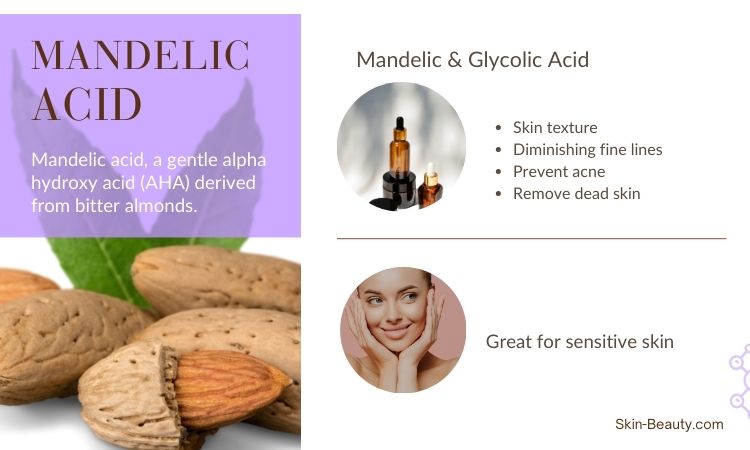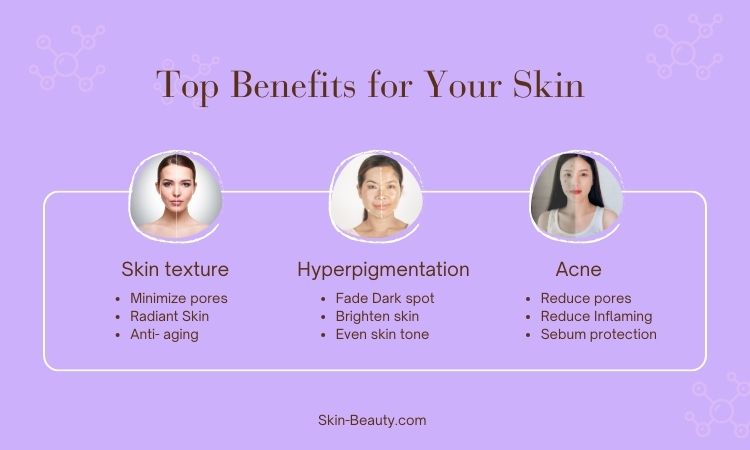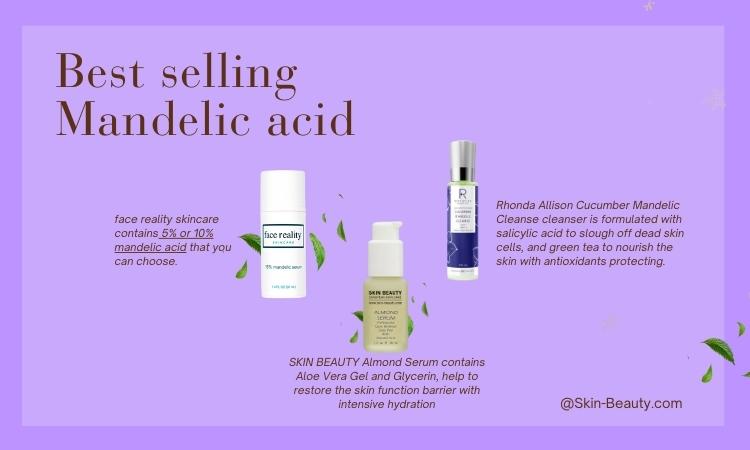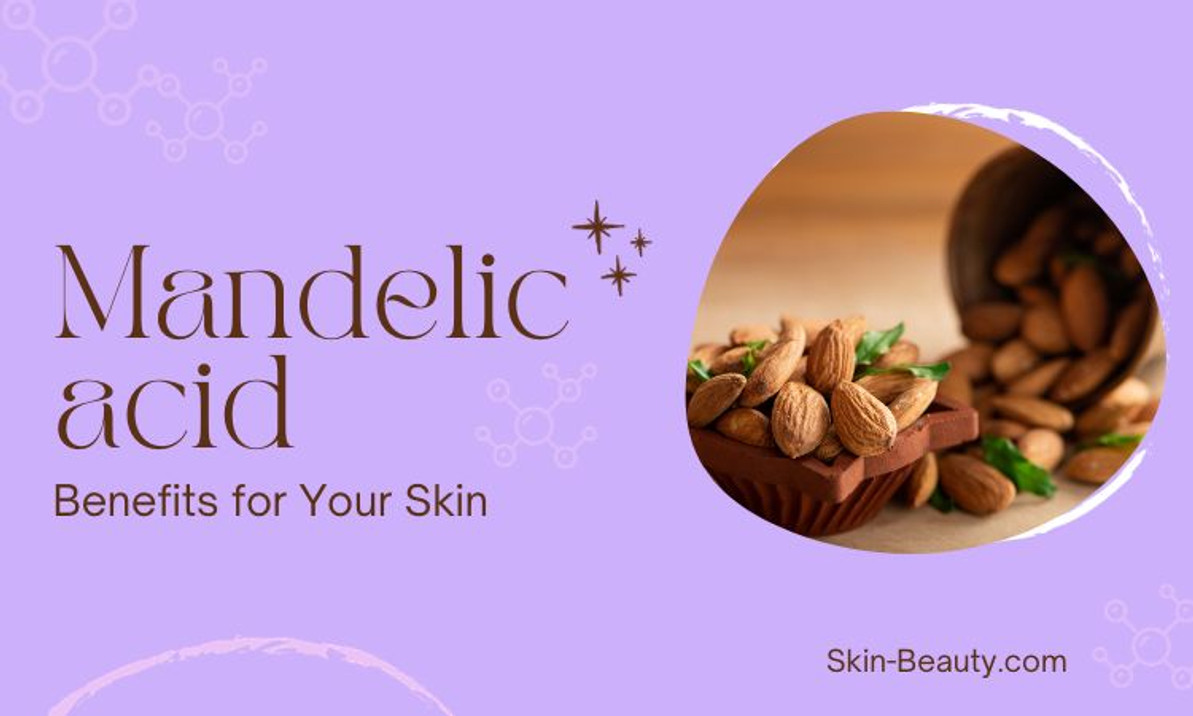Mandelic Acid
Unlock the Beauty Secrets: Discover the Incredible Mandelic Acid Benefits for Your Skin
Are you ready to unlock the secret to radiant, youthful skin? Discover the incredible mandelic acid benefits, a gentle yet powerful alpha hydroxy acid derived from almonds. In this comprehensive guide, we’ll delve into why this superstar ingredient is perfect for sensitive and acne-prone skin, explore its top benefits, and share expert tips on how to maximize its potential. Say goodbye to dull, uneven skin and hello to a brighter, smoother complexion!
Key Takeaways
- Mandelic acid is a gentle yet effective AHA suitable for all skin types and concerns, providing powerful exfoliation with minimal risk of irritation.
- Mandelic acid offers amazing benefits such as managing and preventing acne, improving skin texture & firmness, reducing hyperpigmentation & boosting collagen production.
- With proper application techniques combined with other skincare ingredients in an optimal frequency of use you can achieve radiant youthful skin!
Mandelic Acid: A Gentle Powerhouse

Mandelic acid, a gentle alpha hydroxy acid (AHA) derived from bitter almonds, is a game-changer in skincare. Unlike other alpha hydroxy acids, such as glycolic acid, mandelic acid is known for its gentle exfoliating properties, making it perfect for sensitive skin types. Its large molecular size allows it to penetrate the skin slowly and gently, minimizing the risk of irritation while providing impressive results compared to other alpha hydroxy acids.
Continue to explore the science underpinning this gentle powerhouse and its comparison to other AHAs.
Large Molecular Size
Mandelic acid’s gentle nature is attributed to its large molecular size. With a molecular size twice as large as glycolic acid, mandelic acid penetrates the skin more slowly and gently. This slower penetration helps to minimize skin irritation and skin sensitivity too, making it a fantastic choice for those with sensitive skin or first-time users of AHAs, as opposed to lactic acid which has a smaller molecular size.
The large molecular size also means that mandelic acid is less likely to cause chemical burns or other adverse reactions commonly associated with chemical peels and chemical exfoliants.
Suitable for Sensitive Skin
The gentle properties of mandelic acid render it a suitable choice for sensitive and acne-prone skin. Its larger molecular size compared to other AHAs ensures it is less likely to cause irritation or sensitivity, while still providing powerful benefits. Mandelic acid effectively treats hyperpigmentation, acne, and dullness by regulating sebum production, removing dead skin cells, and reducing inflammation.
Additionally, its antibacterial and anti-inflammatory properties make it a great choice for individuals with skin conditions such as rosacea or eczema.
Comparing Mandelic Acid to Other AHAs
Mandelic acid distinguishes itself from other AHAs with its unique properties, although all AHAs provide exfoliating benefits. Its larger molecular size ensures a slower, gentler penetration compared to glycolic acid, making it more suitable for sensitive skin. Additionally, mandelic acid is just as effective as other AHAs like glycolic acid in improving skin texture, diminishing fine lines, and preventing acne.
This makes mandelic acid a versatile ingredient that can be safely incorporated into various skincare routines for different skin types and concerns.
The Wonders of Mandelic Acid: Top Benefits for Your Skin

Having understood the unique properties of mandelic acid, we will now explore its chief benefits for your own skin care. From managing and preventing acne to improving skin texture and reducing hyperpigmentation, mandelic acid offers a wide range of advantages for various skin types and concerns.
Read on to discover how this remarkable AHA can transform your skin.
Acne Management and Prevention
In the battle against acne, mandelic acid serves as a potent ally. It helps to:
- Regulate sebum production
- Unclog pores
- Reduce inflammation
- Eliminate acne-causing bacteria
By doing so, mandelic acid helps to keep breakouts at bay and prevent future ones, ensuring clearer, healthier skin.
Moreover, mandelic acid’s gentle exfoliation promotes skin cell turnover, leading to a smoother, more radiant complexion. This makes it an excellent choice for those struggling with acne and looking for a solution that is both effective and gentle on the skin. In fact, topical mandelic acid treatment, and skin care products such as mandelic acid peels, are becoming increasingly popular for this very reason.
Improved Skin Texture and Firmness
The exfoliating properties of mandelic acid make it an excellent option for enhancing skin texture and firmness. By effectively removing dead skin cells and promoting cell turnover, mandelic acid helps to reveal:
- Smoother, more radiant skin
- More even skin tone
- Minimized pores
- Firmer, more youthful appearance
In addition to its exfoliating benefits, mandelic acid also stimulates collagen production in deeper layers of the skin, further enhancing its firmness and elasticity. The combination of these effects makes mandelic acid an excellent ingredient for those seeking to improve their skin’s overall texture and appearance.
Hyperpigmentation Reduction
In lightening dark spots and reducing hyperpigmentation, mandelic acid exhibits high effectiveness. By promoting cell turnover and inhibiting melanin production, mandelic acid works to fade dark spots and reveal brighter, more even-toned skin. Whether you’re dealing with sun spots, acne scars, or age spots, mandelic acid can help to significantly improve the appearance of your skin and create a more uniform complexion.
Boosting Collagen Production with Mandelic Acid
Collagen is a key protein that provides structure and elasticity to our skin. As we age, our natural collagen production decreases, leading to wrinkles and sagging skin. Fortunately, mandelic acid can help to boost collagen production and improve skin’s overall appearance.
Next, we will delve into:
- The mechanism of mandelic acid’s collagen-enhancing properties
- Its long-term impacts
- Methods for its combination with other ingredients to yield even more remarkable results.
Mechanism of Action
Mandelic acid promotes collagen production by efficiently removing dead skin cells and acting as an antioxidant to prevent the formation of free radicals. This leads to a smoother, more radiant complexion due to the breaking down of intercellular bonds and increased cell turnover. The exact mechanism of action is not yet fully understood; however, mandelic acid has been found to promote the deposition of collagen, elastin, and GAGs by dermal fibroblasts, indicating its potential as a powerful tool for skin rejuvenation.
Apart from its exfoliating properties, mandelic acid also offers antioxidant benefits, offering skin protection from environmental damage and free radicals. These factors contribute to its ability to promote collagen production, resulting in a firmer, more youthful complexion.
Long-term Effects
The long-term advantages of employing mandelic acid for collagen production hold great promise. With regular use, mandelic acid has been shown to significantly increase collagen production in the skin, resulting in plumper, healthier, and more youthful-looking skin.
As a bonus, mandelic acid’s gentle nature makes it suitable for all skin types, including sensitive and acne-prone skin, allowing a wider range of people to experience these fantastic benefits.
Combining Mandelic Acid with Other Collagen-Boosting Ingredients
To augment the collagen-stimulating effects of mandelic acid, it can be combined with other ingredients renowned for their collagen-promoting abilities, like vitamin C and retinol. These powerful combinations can help to address a variety of skin concerns, from fine lines and wrinkles to uneven skin tone and texture.
By incorporating mandelic acid with other collagen-boosting ingredients, you can create a customized skincare routine that targets your specific needs and delivers impressive results.
How to Incorporate Mandelic Acid into Your Skincare Routine
Introducing mandelic acid into your skincare routine can appear intimidating, particularly for those unfamiliar with using AHAs. Fear not! In this section, we’ll provide tips on choosing the right product, how to apply it safely, and what to avoid in order to make the most of this incredible ingredient.
Choosing the Right Product
The concentration and formulation are critical factors to consider when choosing a mandelic acid product. Skincare products containing 5% or 10% mandelic acid have been found to be safe and effective for the treatment of acne. Additionally, the formulation of the product can impact its tolerability, so it’s essential to choose a product that works well with your skin type and concerns.
By considering these factors, you can confidently pick the perfect mandelic acid product to incorporate into your skincare routine.

Application Techniques
Proper application is vital for maximizing the benefits of mandelic acid. Here’s how to apply it:
- Thoroughly cleanse your skin.
- Apply a small amount of the mandelic acid serum to your face, focusing on areas of concern.
- Allow the serum to penetrate for about 20 minutes.
- Follow up with your regular moisturizer.
- Start by using the serum two to three times a week, gradually increasing to daily use as your skin builds tolerance.
It’s crucial to be mindful of sun exposure when using mandelic acid, as it can make your skin more sensitive to UVA rays. Always apply a broad-spectrum sunscreen daily to protect your skin from sun damage and to avoid any negative side effects. By taking these steps, you can effectively incorporate mandelic acid into your skincare routine and enjoy its numerous benefits.
What to Avoid When Using Mandelic Acid
A few precautions are necessary for a successful skincare routine incorporating mandelic acid. First, avoid using mandelic acid with other exfoliating products, as this can lead to over-exfoliation and damage to the skin barrier. Second, limit sun exposure and always use sunscreen when going outside, as mandelic acid can increase your skin’s sensitivity to UVA rays.
Before trying mandelic acid for the first time, it’s a good idea to perform a patch test to ensure no negative reactions occur. Additionally, speak with a dermatologist or doctor before beginning any new skincare treatment to ensure that mandelic acid is the right choice for your skin type and concerns. By following these precautions, you can safely incorporate mandelic acid into your skincare routine and enjoy its many benefits.
Expert Tips for Maximizing Mandelic Acid's Potential
To fully harness the potential of mandelic acid, following expert recommendations for ideal usage frequency, integration with other skincare ingredients, and skin response monitoring is essential.
In this section, we’ll provide you with valuable tips to help you get the most out of mandelic acid and achieve the glowing, youthful skin you desire.
Ideal Frequency of Use
Your skin’s tolerance and needs dictate the ideal frequency of use for mandelic acid. Start by using mandelic acid once a week, and gradually increase the frequency to twice a week or more, depending on how your skin responds. This allows your skin to gradually adjust to the ingredient, minimizing the risk of irritation and ensuring optimal results.
Combining Mandelic Acid with Other Skincare Ingredients
Combining mandelic acid with various skincare ingredients can safely enhance its effects and tackle specific skin issues. For example, pairing mandelic acid with:
- hyaluronic acid
- sodium PCA
- niacinamide
- vitamin C
- vitamin E
- ferulic acid
- green tea
- caffeine
- centella asiatica
- salicylic acid
- glycolic acid
Experiment with different combinations to find the perfect skincare routine tailored to your skin care routine and your unique needs. It can help improve skin texture, tone, and overall appearance.
Monitoring Your Skin's Response
Monitoring your skin’s response to mandelic acid is key to adjusting your usage and attaining optimal results. Look for signs of comfort, such as a lack of redness, itching, or burning, and note any improvements in skin texture, tone, and overall appearance. If you notice any irritation, try decreasing the frequency of use or switching to a lower concentration product.
By paying close attention to your skin’s response and adjusting your skincare routine accordingly, you can maximize the benefits of mandelic acid and reveal your most radiant, youthful skin.
Summary
In summary, mandelic acid is a gentle yet powerful alpha hydroxy acid that offers a wide range of benefits for various skin types and concerns. By incorporating mandelic acid into your skincare routine, you can improve skin texture, reduce acne breakouts, and diminish hyperpigmentation. With the expert tips provided in this guide, you’re well-equipped to maximize mandelic acid’s potential and unlock the secret to radiant, youthful skin. So, what are you waiting for? It’s time to discover the incredible benefits of mandelic acid for yourself!
Frequently Asked Questions
What does mandelic acid do for your skin?
Mandelic acid is a gentle alpha hydroxy acid (AHA) which helps reduce acne, fine lines, wrinkles and age spots, dull skin, while regulating sebum production, unclogging pores and reducing inflammation. It can also result in a brighter overall complexion, help with acne and reduce the appearance of acne scars.
Can you use mandelic acid everyday?
Mandelic acid is suitable for all skin types and can be used daily, but it's advisable to start with lower concentrations and build up once your skin has become accustomed.
Is mandelic acid better than retinol?
Mandelic acid and Retinol both have their own unique benefits that may depend on the individual needs of the user. While Retinol is a popular choice for anti-ageing, Mandelic Acid is equally effective in targeting blemishes and hyperpigmentation. Ultimately, the best choice depends on what results you are hoping to achieve.
What not to mix with mandelic acid?
Mandelic acid is best used on its own rather than combined with other acids, such as lactic acid, glycolic acid, or salicylic acid. Mixing mandelic acid with other acids may lead to over-exfoliation and discomfort, so it's best to use mandelic acid on its own in the form of serums, creams, and moisturizers.
How long does it take to see results from using mandelic acid?
It usually takes around two weeks to enjoy the benefits of mandelic acid.
Recent Posts
-
Peptides For Skin: Exploring the Anti-Aging Benefits of Peptides in Skincare
Exploring the Anti-Aging Benefits of Peptides in Skincare In the universe of advanced skincare, th …Apr 25th 2024 -
Discover the Perfect Glasses & Styles to Enhance Your Rectangle Face Shape!
Your face shape plays a significant role in determining the most flattering hairstyles and makeup te …Apr 17th 2024 -
Moroccanoil Treatment for Hair: The Ultimate Guide
Moroccanoil Treatment for Hair: The Ultimate Guide In the world of hair care, few products have ca …Apr 1st 2024




